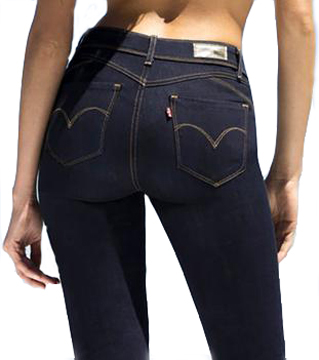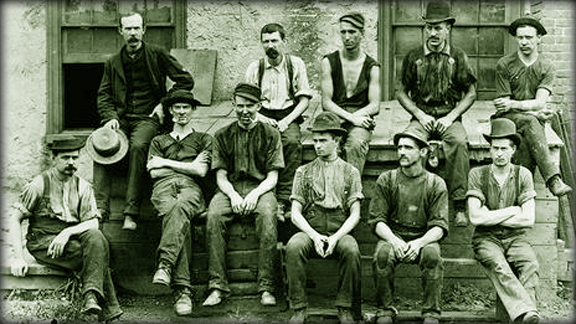|
 Jean
genie: Jean
genie:
The denim evolution
From rugged work-wear
to fashion staple, denim jeans have gone from strength to strength.
Katya Foreman gets the skinny on the ubiquitous trousers.
At once esoteric - with a sacred status among so-called 'denim heads'
- and a mainstream wardrobe staple, the humble jean remains one of the
most deceptively complex and mysterious garments of all time; one that
creates an emotional connection with the wearer. "It's a very personal
thing because of the uniqueness of the dyeing... as you start to wear in
your jeans they kind of take on their own personality; each wear pattern
is unique to the individual. It's something that you wear over time and
that moulds to your body and takes on character," says Kara Nicholas,
from historic denim manufacturer Cone Denim.
Cone's White Oak mill in Greensboro, North Carolina, which produces
all of the firm's authentic premium vintage denims and boasts a
collection of American Draper X3 model shuttle looms from the 1940s,
will celebrate its 110th anniversary on 20 April. "There is a depth and
dimension that happens with those looms," says Nicholas, for whom the
authentic denim trend began in the '80s, "when people started collecting
vintage jeans and there was this idea of trying to emulate or replicate
that authenticity.
We're always looking at the same jeans from the turn of the century
throughout the 1900s for inspiration, experimenting with the yarns or
different dye formulas," she says.
From indigo rockabilly turn-ups to bellbottoms to the ongoing skinny
jean phenomenon (attributed to French designer Hedi Slimane during his
stint at Dior Homme in the early '00s), since the second half of the
20th Century, jeans have been firmly entrenched in the fashion
landscape.
Their roots are wholly utilitarian, however.
Levi Strauss is credited as the co-founder of the blue jean, created
in 1873 in the wake of the California Gold Rush that had taken place a
couple decades earlier.
On its website, Levi's shares the story of the Bavarian-born Strauss,
who moved to San Francisco from New York in 1853 to open a wholesale dry
goods business.
There he was approached by one of his tailor customers, Jacob Davis,
who was looking for a business partner to patent a trouser design
featuring rivets positioned at points of strain to make them last
longer.
The patent (for the process of putting rivets in men's work trousers)
was granted to Jacob Davis and Levi Strauss & Company on 20 May 1873,
creating a new category of workwear and marking the birth of the blue
jean. According to Levi's, the first blue jean design - originally
referred to as XX "waist overalls" - had a single back pocket with an
Arcuate stitching design, a watch pocket, a cinch, suspender buttons and
a copper rivet in the crotch.
|

01 Sep 1895- 1890s Factory Workers Seated Outside Of
Building - Image by Ā© H. Armstrong Roberts Classic Stock
Corbis |
The garment's main ingredient - denim - is said to have originated in
the French town of Nīmes, with its name an Americanisation of its local
moniker, Serge de Nīmes (in English, Serge from Nīmes). Characterised by
a natural and indigo warp and weft, the robust cotton twill fabric in
the 19th Century was used to make trousers worn by sailors from Genoa in
Italy, regarded by some as the ancestor of the jean, with the French
word for Genoa - Gźnes - said to have inspired the word jean.
Keks appeal
Billed as 'riveted-for-strength workwear made of true blue denim'
Levi's Two Horse brand leather patch - created in 1886 - depicted a pair
of jeans suspended between two workhorses, as a symbol of strength.
In 1890, the XX model, which went on to be adopted as the uniform of
horse wranglers out west, was given the lot number '501'.
A version with two back pockets was introduced in 1901, with belt
loops added in 1922.
The red tab was added on the right back pocket of the overalls in
1936 "to differentiate Levi's overalls from the many competitors in the
marketplace who were using dark denim and an Arcuate stitch", according
to Levi's.
As Hollywood Westerns sparked an interest in the cowboy lifestyle,
blue jeans started filtering into the mainstream in the 1930s, then
bubbled up through youth culture in the 1950s under the influence of
Hollywood rebels in jeans like James Dean.
Teens are said to have started using the word 'jean' in the same
decade but it wasn't until 1960 that Levi's replaced the term 'overalls'
with 'jeans' in advertising and on packaging.
The first television commercial for Levi's jeans aired in 1966, with
a women's shrink-to-fit 501 model introduced in 1981, accompanied by the
iconic Travis TV ad.
Adding another twist to the tale, for many denim connoisseurs today
it is Japanese "selvage" or "self-edge" denim that is deemed the real
deal, produced on traditional shuttle looms - with 100% cotton threads
and real indigo dye - using vintage machines that were abandoned by
American denim mills in favour of more cost-effective industrial
processes. Selvage refers to the clean woven edge on denim produced on
shuttle looms, as opposed to the frayed, cut edge on denim produced on
wide, modern equipment.
Fabric of society
Where denim's rugged, hard-wearing nature drove its utilitarian
beginnings, revolutionary stretch fibres have helped fuel its flight in
the fashion domain, gaining momentum in the '00s, the era of the jegging.
The introduction of Lycra Spandex literally expanded opportunities,
confirms Cone's Nicholas, who cites among other key evolutions
sustainable fibres and performance denims -"trying to bring the function
into fashion".
Cone regularly partners with fibre and yarn companies like Invista on
such innovations.
A case in point is their recent hook-up with Unifi, whose Repreve
technology, which produces fibres made from recycled water bottles, was
used to create the Cone Touch fabric.
"They used a special spinning technique to mimic the hand and look of
a cotton yarn but it has all the strength and benefits of a synthetic
fibre," says Nicholas.
"Ultimately the idea is whatever we do with regards to
sustainability, technology, performance, we always want to try to
maintain the look and hand of a cotton denim;
Jeanologia, a firm based in Valencia, Spain that specialises in
industrial laser machinery is among pioneers of new planet-friendly
technologies for replicating worn effects and denim washes (the term
used for finishes on denim), one of the most polluting activities in the
apparel industry. The company's sales pitch centres on authentic denim
that takes a couple of hours to produce.
"It's this idea that jeans have a soul, that they become a part of
you, as the way they wear is unique to each person.
When we go to the denim store, subconsciously we are looking for
something similar to our favourite old pair of jeans," said Enrique
Silla, Jeanologia's CEO, who views the way water and chemicals are used
in the textile industry as "prehistoric". Such advances, he believes,
are set to revolutionise an industry scrambling to clean up its act, and
20% of denim manufacturers now working with the firm's technologies,
according to Silla.
you're always trying to maintain that look."
With over five billion jeans produced per year, average yearly denim
consumption represents 1.5 pairs of jean per capita in Europe, and 4 per
capita in the US, soon to rise to "one jean per capita across the
planet," according to Silla.
In a back-to-the-future approach, the denim industry continues to
look to the original blue jean for new inspirations.
- BBC Magazine
|

